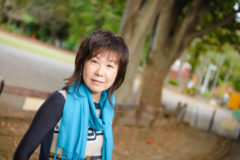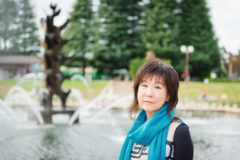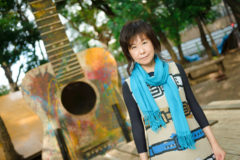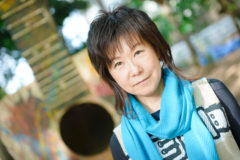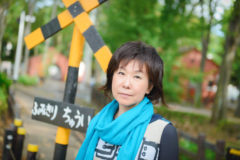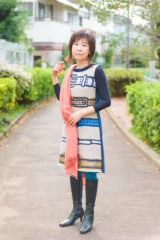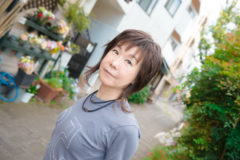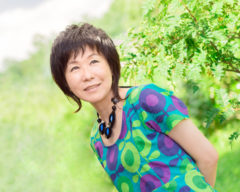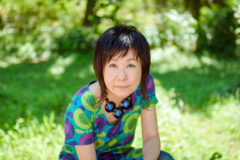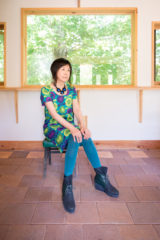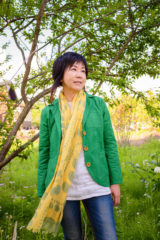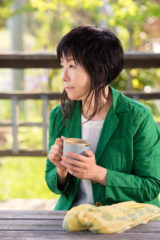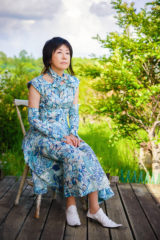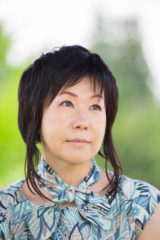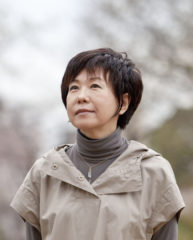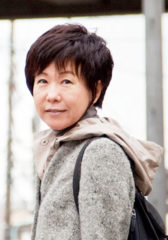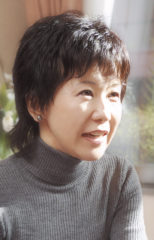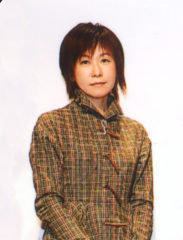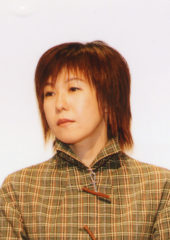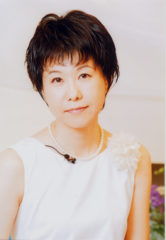PROFILE
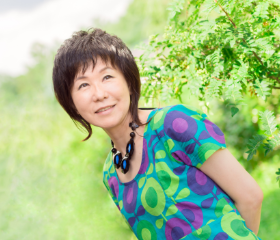
作詞家・詩人
山梨県出身。13歳から千葉県松戸市で過ごす。東京都在住。早大一文卒。平原綾香、smap、新垣勉、夏川りみ、小泉今日子、沢田研二、クミコ、ムーンライダーズなどの作詞で、多くの作品をCD化。NHK全国学校音楽コンクール課題曲、校歌、市歌、合唱組曲等の作詞なども多く手がける。
1992年より国内外各地で自作詩朗読ライブを展開し『朗読するための物語詩』の独自分野で評価を受ける。
2001年『千と千尋の神隠し』主題歌『いつも何度でも(曲・歌唱/木村弓)』の作詞でレコード大賞金賞。 2008年3月、企画・補作・監修した「星つむぎの歌」(平原綾香・歌)が土井隆男宇宙飛行士のウェイクアップコールとして大気圏外で使用される。
同年5月公開の映画『ヤーチャイカ(アンジェリカ制作、主演/香川照之、尾野真千子)』では、原作・脚本・監督(共同監督・谷川俊太郎)をつとめる。 2009年舞台『届かなかったラブレター(主演/井上芳雄・クミコ / ル・テアトル銀座)』の構成・演出を担当。
2012年より震災ドキュメンタリー映画『きょうを守る(監督・菅野結花)』の米国各地の上映会に主題歌『ほしぞらとてのひらと(曲・丸尾めぐみ)』を届けて現地との交流を図る。
詩集に『ゼロになるからだ』(徳間書店)、『海のような大人になる』(理論社)『はじまりはひとつのことば』(港の人)、『2馬力』(ナナロク社/谷川俊太郎と共著)など。自唱ソロCDに『青空1号』(04年ソニー)、『カルミン』(09年valb)、『ベジタル』(14年valb)、『シードル』(17年モモランチ)がある。エッセイ、絵本など著作多数。
自らのバンドを率いての自唱ライブ活動、朗読会、ワークショップなどのほか、詩作の過程をスクリーンに投影して観客と共有するイベント<ライブ対詩>を谷川俊太郎と共に2014年から継続している。
2014年より米国ミドルベリー大学日本語学校特別講師。
詩作を軸足にマルチな活動を展開。
Profile
Wakako Kaku (September 1, 1961 – ) is a Japanese lyricist, poet, singer-songwriter. To many Japanese people, Wakako Kaku is known as a lyricist for famous pop singers and the theme songs of Hayao Miyazaki’s animated films, including Spirited Away, for which she won a prestigious Record Taisho award, the Japanese equivalent of the Grammy.
History
1985: Began her career as a lyricist by providing lyrics to an avant-garde rock band, ‘Cioccolata’. Since then, she has provided lyrics to Kenji Sawada, Moonriders, FAIRCHID, ORQUESTA DEL SOL, Ayaka Hirahara, SMAP, Rimi Natsukawa, Kumiko, Tsutomu Aragaki, etc.
1992: Started poetry reading performances both within and outside of Japan. Kaku created her own new style of story-telling poetry called “Monogatari Shi” (物語詩, narrative poetry)which was highly praised.
2001: Won the 43rd Record Taisho award and the 25th Japanese Record Award for”Itsumo nandodemo” (いつも何度でも, Always With Me / Many Times Always sung by Youmi Kimura) , the theme song of the movie “sen to chihiro no kamikakushi” (千と千尋の神隠し, Spirited Away ).
2004: Released the first solo album “Aozora ichigō” (青空1号, Blue Sky#1) from Sony Music Direct.
2008: Co-produced with Hayao Miyazaki, “Umi no okāsan” (海のお母さん, Mother of the Sea), the opening theme song of the movie “Gake no ue no ponyo” (崖の上のポニョ, Ponyo on the Cliff ). Kaku’s works include the first collection of story poems “Zero ni naru karada” (ゼロになるか らだ, Body Becoming Zero) published by Tokumashoten, ‘Umi no youna otona ni naru’ (I Will Be a Grown-up Like the Sea), bublished by Rironsha and essays, translated children’s books and more. Ya Chaika She wrote an original story, scripted and co-directed (with Shuntaro Tanikawa) the film “Ya Chaika”. Hoshitsumugi no uta The song “Hoshi tsumugi no uta” (星つむぎの歌, Weaving of Stars Song, sung by Ayaka Hirahara), which was planned, supplemented and supervised by Kaku was used in the outer atmosphere as a wake-up call for astronaut Takao Doi.
2009: Stage directed ‘Todokanakatta rabu retā’ (Love Letters Never Delivered), starring Kumiko and Yoshio Inoue at Le Theatre Ginza.
2010: Released her 2nd album ‘Karumin’ with the record label VALB.
2012: Released a single CD ‘Hoshizora to tenohira to (Starry Night and Palms)’, a theme song for the earthquake documentary film ‘Kyō wo mamoru (Protecting Today), directed by Yuka Kanno’.
2013: Began teaching at Middlebury Japanese Language Schools (Summer Program) in Vermont.
2014: Released her 3rd album ‘Vegetal’ with VALB.
2017: Released her 4th album ‘cidle’ from her workspace Momo-Launch.
Kaku has been participated in
Shizuoka Renshi (Linked Poem): 2010, 2012, 2014, 2015, 2017 and 2019 Kumamoto Renshi :2010 Roppongi Renshi: 2014
Inspiration and Style
Kaku is also known as a movie director, theatre producer, essayist, translator, vocal performer, and even a singer, with two solo albums. On her official fan website is a diagram entitled the “Kaku Chart”, which consists of a Venn diagram of three circles representing the activities ‘Produce’, ‘Sing’ and ‘Read’. Each of these link to the nine different genres in which she is active. Though seemingly diverse, her ventures knit together to form a universe whose centre of gravity is in fact poetry. Wakako Kaku began working as a lyricist upon graduating from Waseda University in Tokyo, but remained drawn to poetry as a means of “physical expression” over the years. In 1992 she gave a poetry-reading performance on a small island together with local children; this for her was a turning point. Being married to a Rakugo performer, a comic storyteller in the traditional Japanese fashion (and wholly different to the taciturn potter husband of the narrator in her poem ‘Dear Ceramic Artist’), must also have helped her to realise the physical aspects of poetry: husband and wife have collaborated on various types of vocal performances.
The interplay between poetry and the human body, be it in the form of reciting, singing or dancing, two concepts which were inseparable in the days of purely oral communication, has been somewhat diluted since the introduction of the written language, and has become more or less neglected in contemporary Japanese poetry, which often seems too intellectual to pay attention to corporeal matters. Kaku tries to bring back the body to poetry, not only by performing poetry on stage but also by expressing the physical elements of our being in her writing:
Your skin is there to feel the breeze on your finger as it points to the sky Your shoulders are there to catch flower petals Your lips are for kissing Your cheeks are there to be kissed, isn’t that right? When each and every one of them is used just as it is supposed to be your body comes alive, doesn’t it? (from ‘Body’)
In this regard, the title of her first poetry collection, Body Becoming Zero, is intriguing: it seems that Kaku searches, through her poetry, for a meeting-point between the body and the spirit in the depth of the human soul, where the boundary between reality and fantasy, or the living and the dead, is also blurred. Kaku’s poems work on our mind similar to the way in which folklore does, and her recitation of them reminds one of traditional storytellers. Two of the poems presented here, ‘Ogre Inside’ and ‘My Dear Ceramic Artist’, best exemplify these characteristics of her poetry.
William I. Elliott and Kazuo Kawamura translated ‘Applause’ and Takako Lento translated the other poems featured here. We also publish here an essay by Takako Lento in which she discusses ‘Ogre Inside’ and ‘My Dear Ceramic Artist’ in particular. Written in the spirit of the traditional storytelling, these poems are filled with everyday details of modern Japanese life, so Lento’s essay should be helpful as a readers’ guide. © Yasuhiro Yotsumoto
Selected Works
Poetry
“Zero ni naru karada” (ゼロになるからだ, Body Becoming Zero), published by Tokuma Shoten, Tokyo, 2002 “Umi no youna otona ni naru” (海のような大人になる, I Will Be a Grown-up Like the Sea), published by Rironsha, Tokyo, 2007 Yes, co-authored with Photographer Junji Takasago, published by Shōgakukan, Tokyo, 2015 “Poetaro orakuru kādo” (ポエタロ オラクル カード, Poetaro Oracle Card) published by Chiyūsha, Tokyo 2015 “Hajimari wa hitotsu no kotoba” (はじまりはひとつのことば, In the Beginning There Was a Word), published by Minatonohito, Tokyo 2015 “2 Bariki” (二馬力, 2 Horsepower), co-authored with Shuntaro Tanikawa, published by Nanarokusha, Tokyo 2017
Essays
“Seiten hakujitsu” (青天白日, Blue Sky White Day), published by Shohbunsha, Tokyo, 2004 “Chōgakusei de deatteokitai 55 no kotoba” (小学生で出会っておきたい55の言葉, 55 Words of Wisdom You Want to Know in Elementary School) , published by PHP Kenkyūsho, Tokyo, 2014 “Chūgakusei de deatteokitai 71 no kotoba” (中学生で出会っておきたい71の言葉, 71 Words of Wisdom You Want to Know in Junior High School), published by PHP editor’s group, Tokyo, 2012 “Kōkōsei de deatteokitai 73 no kotoba” (高校生で出会っておきたい73の言葉, 73 Words of Wisdom You Want to Know in High School), published by PHP editor’s group, Tokyo, 2012
Children’s Books
Neh (You know . . . ), co-authored with Shuntaro Tanikawa and Akira Sato, published by Froebel Kan, Tokyo, 2008 Hugtime (translation from English, originally written by Patrick McDonnell), published by Asunaro, Tokyo, 2008 Nedoko doko kana (translation from English, originally written by Judy Hindley), published by Shōgakukan, Tokyo, 2006 Hoshitsumugi no uta (Weaving of Stars Song) CD Picture Book , published by Kyōbunsha, Tokyo 2019 Shiawase no chīsai tamago (translation from English, originally written by Ruth Krauss), published by Asunaro Shobō, Tokyo, 2015
Music Albums
“Aozora ichigou” (青空1号, Blue Sky #1), GT Music, Tokyo, 2004 Karumin, Space Shower Music, Tokyo, 2010 Vegetal, VALB, Tokyo, 2014 cidre, Momo-launch, Tokyo, 2017
Directed Film
Ya Chaika, co-directed with Shuntaro Tanikawa, Frontier Works Inc., Tokyo, 2009
External Links
Wakako Kaku’s official fan site official website of Yah Chayka! (I, Seagull) , a film Wakako Kaku co-directed with poet Shuntaro Tanikawa Wakako-Kaku Kaku’s achievements featured in the Poetry International Archives.
HISTORY
- 2024年 EVENTS 言葉のワークショップ2024「言葉という自分に向き合う」
- 2024年 WORKS イラストレーターの華鼓さんとのコラボ絵本発売
- 2024年 RELEASE 2024年4月 新刊「かっぱ語録 /谷川俊太郎、覚和歌子共著」角川春樹事務所より発売予定
- 2024年 EVENTS 2024年1月 会員制イベント @都内
- 2023年 NEWS 月刊すこ~れに詩の連載
- 2023年 WORKS 2023年9月27日 中学生のための新しい教材集「タイムリーパー」(教育芸術社)発売
- 2023年 EVENTS 2023年11/13(月) <長岡商工会議所女性支部発足20周年記念コンサート>@長岡
- 2023年 EVENTS 2023年9/24(日)14:30〜 「星つむぎの歌」15周年記念コンサート<星に歌えば> @山梨
- 2023年 NEWS 2023年9/16(土)〜11/12(日) [九鬼(くかみ)祭 2023」@奈良
- 2023年 EVENTS 2023年8/26(土).27(日) 全日本お母さんコーラス全国大会@姫路
- 2023年 EVENTS 2023年7/20(木)〜8/8(火) 米国ミドルベリー 大学にて特別講義
- 2023年 EVENTS 2023年7月2日(日)<いのちの学校 WILD WOMAN2023>
- 2023年 RELEASE 2023年6月12日(月)発売書籍「ジュリーがいた」文芸春秋社刊
- 2023年 WORKS 5月 覚和歌子詩集
- 2023年 EVENTS 2023年6月18(日)13:00〜16:30「覚和歌子による詩作オンラインワークショップvol.4」
- 2023年 OTHERS 2023年5月14(日)25時よりラジオ出演@J-WAVEラジオ
- 2023年 WORKS 覚さんが作詞で参加した合唱曲集グリークラブ・ソングセレクションⅠ発売
- 2023年 NEWS 2023年3/15(水)覚和歌子詩集発売
- 2022年 WORKS 12月 中学生のための新しい教材集 天球図【楽譜】
- 2022年 覚さんが作詞で参加した合唱曲集ドラゴンソング発売
- 2022年 WORKS 9月 「古事記物語」(鈴木三重吉著/角川春樹事務所刊) 巻末エッセイ
- 2022年 EVENTS 9月 オンライン詩作ワークショップ@岩手たまくさ
- 2022年 EVENTS 2022年10月8日(土)「ゼロトクロ vol.2 〜生誕祭」@浅草/東洋館
- 2022年 EVENTS 2022年9月24日(土) 「魂のいちばんおいしいところ」 @石川県小松市称名寺
- 2022年 EVENTS 2022年9月18日(日)覚 和歌子朗読会 @山形県遅筆堂文庫
- 2022年 EVENTS 2022年9月17日(土)〜11月13 日(日) MindTrail 2022 @奈良県天川村
- 2022年 2022年8月31日(水)<第60回フレーベル少年合唱団定期演奏会> @東京芸術劇場コンサートホール(東京都豊島区)
- 2022年 EVENTS 2022年8月1日(月)〜12日(金) オンライン 米国ミドルベリー 大学日本語学校特別授業 (8/12のみ 講演会)
- 2022年 EVENTS 2022年7月31日 第2回COSMOSフェス/ゲスト出演 @長野県原村 八ヶ岳自然文化園
- 2022年 EVENTS 2022年7月18日 合唱団ひぐらし第28回定期演奏会「いろはのく」/ゲスト出演 @武蔵野市市民文化会館大ホール
- 2022年 EVENTS 2022年7月9日(土) 中川五郎個展 朗読イベント/ゲスト出演 @吉祥寺 gallery Shell102
- 2022年 NEWS 6月 オンライン詩作ワークショップ@星つむぎの村
- 2022年 NEWS 2022年6月18日(土)「ゼロトクロ」〜覚 和歌子と黒川隆介による朗読会@学芸大学チェロキーライブタバーン
- 2022年 NEWS 2022年4月29日ニコニコ超会議シェアハピラジオ@幕張メッセ
- 2022年 RELEASE 4月 谷川俊太郎詩集 あとがき
- 2022年 WORKS 4月 Peace Animal’s Home テーマソング
- 2022年 WORKS 2022年8月31日 覚和歌子&信長貴富 書下ろし組曲「ドラゴン ソング」初演
- 2022年 OTHERS 4月 五大路子さんが覚さんとの馴れ初めを語る@ラジオ日本
- 2022年 NEWS 五大路子トーク&朗読 @よみうりカルチャー横浜
- 2022年 EVENTS 4月 中川五郎個展にゲスト出演@吉祥寺shell102
- 2021年 EVENTS 12月 フレーベル児童合唱団コンサート 8/31に再々延期 @東京芸術劇場
- 2021年 EVENTS 12月 @東京都日野市ひの煉瓦ホール 日野市立七生緑小コンサート
- 2021年 OTHERS 12月 覚さんの書き下ろし曲で日野市立七生緑小がNコン2021優勝
- 2021年 EVENTS 12月 日本うんこ文化学会 @石川県小松市 サイエンスヒルズ小松
- 2021年 OTHERS 11月 帝国ホテル会員誌「インペリアル」に巻頭エッセイ「龍の起源」
- 2021年 NEWS 10月 上映会「もうひとつの身体」のトークイベントに出演
- 2021年 EVENTS 8月 MindTrail 奥大和 心の中の美術館 vol.2
- 2021年 EVENTS 8月 フレーベル少年合唱団定期演奏会
- 2021年 NEWS 10月29日&11月19日(金) 詩作ワークショップ@オンライン
- 2021年 RELEASE 7月 譜面本『夕焼けパレード』
覚和歌子 宣材用フォトデータ
チラシやポスター、その他宣材関係で写真をお使いの際は以下のページより画像をドラック&ドロップにてダウンロードしてください (ご本人承諾済み)。
なお、いかなる場合も無断使用は禁止いたします。
必ず覚和歌子さんへご連絡下さい。
※ ご使用の際は必ず ©(撮影者名) を入れてください。


